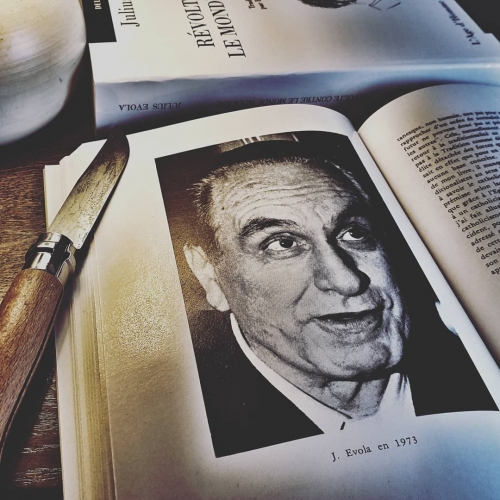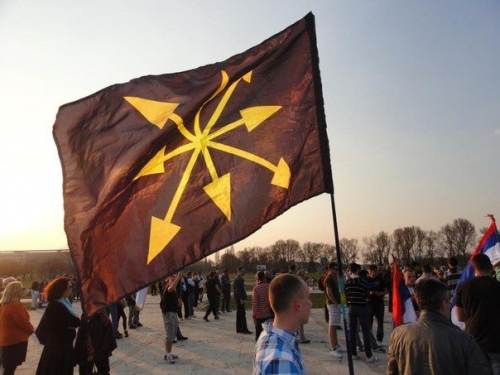
Evola and Neo-Eurasianism
We must understand Julius Evola’s work in the same vein as we understand Heidegger’s approach to metaphysics and Western civilization.
While we can know, for sure, that the current state of Western civilization no longer resembles, in toto, the idealistic image once pictured by Heidegger and Spengler, we must be aware that their work constitutes an important and vital watershed.
The spirit of of old Europe is alive in Heidegger’s work, just as much as in Evola’s work. Both represent the spirit of an age that knew – intimately, perhaps – the Nietzschean drive to its deep modernistic roots and its essence, and perhaps could be depicted in a certain sense as representing the age of the (aspiring) Overman, the active nihilist, and of the regimes that sought a new model of man – many of them Fascist, Communist or even Liberal – as opposed to the current age of the Last Man, a man who has lost the Faustian drive almost entirely and therefore succumbed to passive nihilism, and to the spirit of an age that has fully transitioned from Modernity to Post-Modernity. An age that now consequently, in our current epoch, faces complete dissolution.
Evola addresses this age of dissolution just as intensively and concisely as Heidegger deconstructs the essence of Western logos and of its Metaphysics focused on unreal abstract presences, on reified essences, and on the thinking subject.
We must understand Evola as a savant who was deeply aware of his own role within the End Times, and the sort of distillation, of objectivity (sachlichkeit), that would be necessary in confronting the dimensions and challenges given in our age. We must sense, in him, a man who grasped the inevitable dissolution and destruction of the standards of the bourgeois era, and the age of so-called “Old” Europe, of the Europe that was still recognizable to a man like Oswald Spengler, and about whose inevitable destiny Goebbels firmly proclaimed – as he spoke, during the aftermath of the Dresden bombing and the late 2nd major global confrontation: “all of old Europe comes crashing down, and will be buried, with this war. With this conflict, comes down the ruin of the bourgeois age.” [rough translation]
Even if this fundamentally correct intuition did not come in the style of perverted Nazi dreams, with the construction of the fascist Neue Ordnung, but instead with the building of a demented, sick, geriatric and nihilistic liberal regime within an Americanized mold, we must still see in Evola a sort of logical conclusion to the presuppositions that have so far underlined the later stages of European reaction.
Evola must be understood as constituting the bridge from late Western European continental thought, to Tradition as we should know, and properly understand in the conception that must underlie the foundations of a new, post-liberal civilization that we – as men of the Midnight – must necessarily aspire to.
The very movement of Evola’s life, from the Absolute Idealism of his youth, towards the Neo-Platonic intellectual rigidity, the cemented and refined orthodoxy of the “late” Evola, is indicative of the way that we should take in our age.
Evola wrote precisely for us, the men of the midnight. His writings concerned not just the critique of late Western metaphysics, from a partial point of view that is perhaps much more complete in the work of Rene Guenon and Martin Heidegger, but carries in itself the apocalyptic and eschatological vision of the End – although within Evola’s work, we must understand the undertones of this view of the End Times as being fundamentally different from the Semitic bluster of emotions that have characterized our understanding of the term within Christian civilization.
Evola’s view of the End Times is strictly aligned with a different Orthodoxy, namely, that of Platonism, Hermeticism, Buddhism in its early purer form, and also Samkhya, Advaita and other such currents that can still be discerned in our age. In them, while the End Times and the Dark Age form a coherent given, there’s a marked absence of the pathos of the Semitic type within the scope of these alternative traditional teachings.
The current age of liberal decadence, of the end of Western humanity, must be understood within the aegis and scope of the broad movement of dissolution, of fragmentation, that precedes the end of the cycle. And this is followed, markedly, by the search for transcendence in a world that has become meaningless, formless, objectified, banal and the passive receptacle of a process very similar to the fetish of commodities described by Marxist ideologues. And within this dystopian world of the late times, we can also witness the correspondence made in a very precise fashion with the age of the fourth caste, the age of the Sudra – characterized for instance by the domination of the formless mass man, of pure quantity and of machines – as opposed to the previous bourgeois age that retained the remnants of deeper, older organic elements.

Within this age, and within the West, we must acknowledge that everything that was still organic and traditional in the previous “bourgeois” age, that ended most definitely in 1945, is now coming to an end or has already been destroyed. The anti-modernist teaching of the Roman Church was killed and buried together with its ceremonial and liturgical core, and so were the remnants of the organic, pre and anti-modern social elements, like the aristocracy, the clergy, and the broad aristocratic and hierarchical structures that still played their role in granting a deep and effective sense of societal and personal differentiation no longer present in our day and age.
In our age, which is marked deeply by the liberal and also former Communist erosion of all the remaining standards of organic civilization, we cannot count on the luxury of having the old models and superstructures present within our current milieu. The organic society of the Renaissance, and its predecessor, the organic society of the Middle Ages, are now but a distant memory. What is present right now is precisely the inorganic model of the civilized, late liberal world, that drags itself inexorably towards a vortex of imbecility, downwards leveling of the social structure, and also self-disintegration. Of this, we can only take into account the brilliant work “Jihad vs McWorld”, the sort of book that bears a title very fitting to the current age of Spenglerian early Caesarism, money politics, and solidification.
We have already discussed briefly here and elsewhere the nature of this age. And now, we must understand that when the West lies close to its stage of effective mortality, the initiative must be seized decisively towards a new direction. This initiative consists in the gathering of the men of the Midnight, the differentiated men who “ride the tiger”, to the construction of a new paradigm that must necessarily come after the deep, dark night of Western modernity, and that shall come to the fore as the necessary civilizing Traditional force over a world in ruins. Of a world that has lost sight of itself, and has submerged itself into the most elementary and animal-like barbarity.